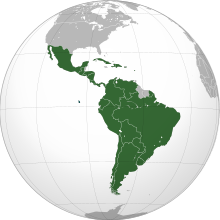
Back Latyns-Amerika Afrikaans ላቲን አሜሪካ Amharic America Latina AN लैटिन अमरीका ANP أمريكا اللاتينية Arabic ܐܡܪܝܩܐ ܠܐܛܝܢܝܬܐ ARC امريكا اللاتينيه ARZ América Llatina AST Latın Amerikası Azerbaijani لاتین آمریکا AZB
 | |
| Area | 20,111,457 square kilometers (7,765,077 square miles)[1] |
|---|---|
| Population | 656,098,097 (2021 estimate)[2][3][a] |
| Population density | 31 per square kilometer (80 per square mile) |
| Demonym | Latin American |
| Countries | 20[b] |
| Dependencies | 13 |
| Languages | Mainly: Spanish, Portuguese, and French Others: Quechua, Haitian Creole, Mayan languages, Guaraní, Aymara, Nahuatl, Italian, German, English, Dutch, Polish, Ukrainian, Welsh, Yiddish, Chinese, Japanese |
| Time zones | UTC−2 to UTC−8 |
| Largest cities | (Metro areas)[4][5] 1. São Paulo 2. Mexico City 3. Buenos Aires 4. Lima 5. Rio de Janeiro 6. Bogotá 7. Santiago 8. Belo Horizonte 9. Guadalajara 10. Monterrey |
| UN M49 code | 419 – Latin America019 – Americas001 – World |
Latin America is the part of the Americas where the people speak Romance languages: Spanish or Portuguese. This includes most of South America and Central America (also including the Spanish-speaking and sometimes the French-speaking Caribbean islands).
The places in the Americas which speak French (Haiti, French Guiana and the French-speaking Caribbean islands) are not always included as a part of Latin America, although French is also a Romance language.[6]
Latin America has vibrant artistic and cultural traditions. Latin American literature, music, and arts are world famous.[7]
In the United States, the term "Latino" refers to a person who has Latin American heritage. It is different from Hispanic which would only include countries where Spanish is the official language. For example, Hispanic would not include Brazil because its official language is Portuguese.
In Spanish, "latino" is a masculine term (for boys and men) whereas "latina" is a feminine term (for girls and women). In the English language, "latino" is not associated with gender so it is an all-inclusive term (male, female, and non-binary). In the 2010s, the term "Latinx" was created to be a gender-neutral term but very few Latinos actually use it.[8]
- ↑ "World Development Indicators: Rural environment and land use". World Development Indicators, The World Bank. World Bank. Retrieved September 12, 2013.
- ↑ "World Population Prospects 2022". population.un.org. United Nations Department of Economic and Social Affairs, Population Division. Retrieved July 17, 2022.
- ↑ "World Population Prospects 2022: Demographic indicators by region, subregion and country, annually for 1950-2100" (XSLX). population.un.org ("Total Population, as of 1 July (thousands)"). United Nations Department of Economic and Social Affairs, Population Division. Retrieved July 17, 2022.
- ↑ Cite error: The named reference
brookingsgdpwas used but no text was provided for refs named (see the help page). - ↑ Geography Department at Loughborough University, The World According to GaWC 2012, Table 4
- ↑ Colburn, Forrest D (2002). Latin America at the End of Politics. Princeton University Press. ISBN 978-0-691-09181-5.
- ↑ "Latin American literature". Encyclopedia Britannica. Retrieved 2021-07-31.
- ↑ ""Latinx" is Unpopular with Actual Latin Americans, Poll Shows".
<ref group=lower-alpha> tags or {{efn}} templates on this page, but the references will not show without a {{reflist|group=lower-alpha}} template or {{notelist}} template (see the help page).
© MMXXIII Rich X Search. We shall prevail. All rights reserved. Rich X Search